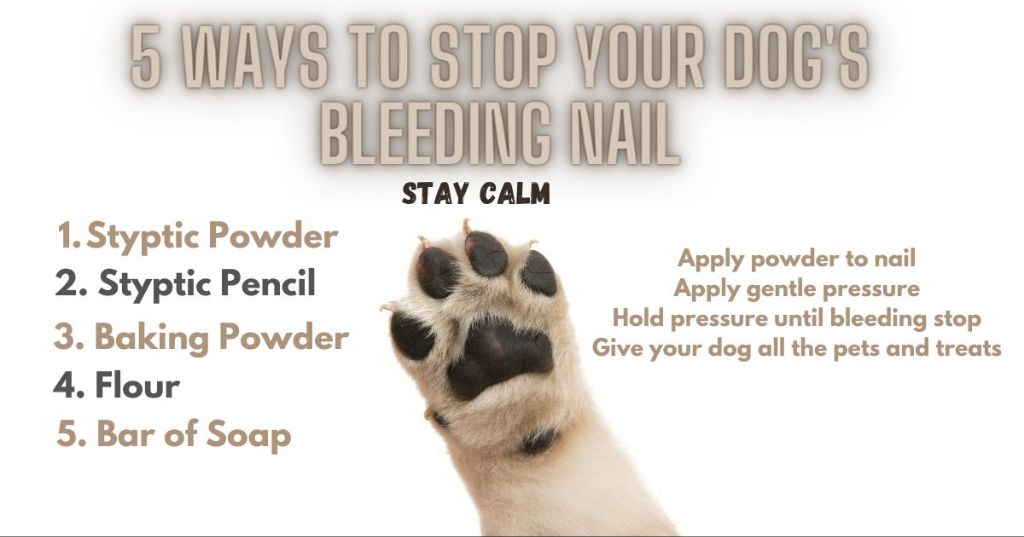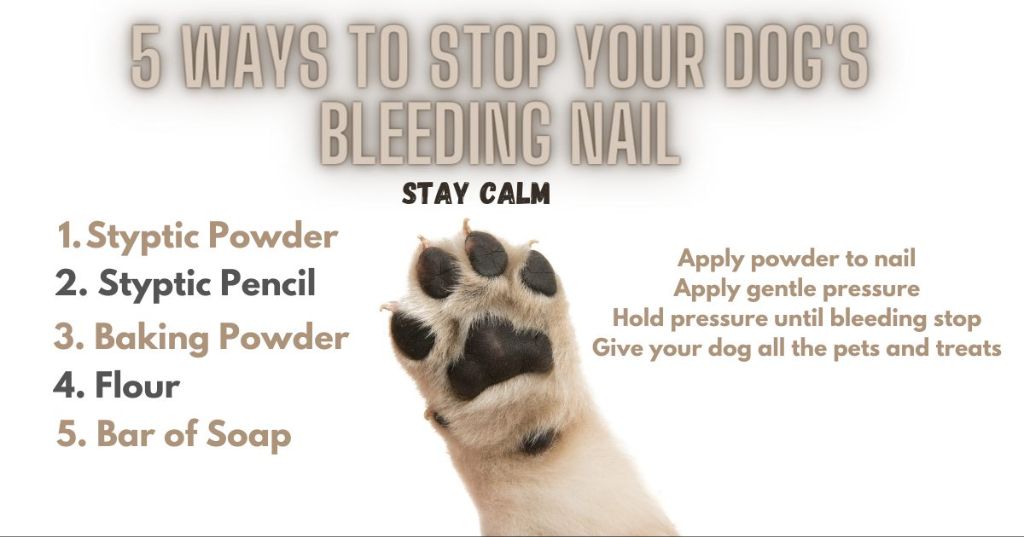Introduction
Dog nail bleeding is a common occurrence that can happen for various reasons. The main cause is when a dog’s nail is cut too short, hitting the quick and causing it to bleed. The quick is the living soft tissue inside the nail that contains nerves and blood vessels. Cutting into the quick is painful for dogs and results in bleeding.
Other causes of nail bleeding include nails splitting or breaking, getting caught on surfaces, injuries, and nail or skin conditions. Bleeding nails can seem alarming but are usually not an emergency. There are ways to stop minor bleeding at home. However, if the bleeding is excessive or doesn’t stop, veterinary attention is required.
Risks of nail bleeding include infection or continued blood loss. It’s important to stop bleeding to avoid these complications. Signs to see a vet immediately include bleeding that won’t stop after an hour, large amounts of blood loss, the nail is partially missing or hanging off, or the paw is injured.
Apply Pressure
The first step when your dog’s nail is bleeding is to apply direct pressure to stop the bleeding. You can use a clean piece of gauze, cloth, or paper towel for this. Gently press on the nail near the quick, using enough pressure to stop the bleeding. Hold the pressure for 2-3 minutes continuously to allow a blood clot to form. According to Glad Dog Nation, a blood clot will typically form after applying pressure for 2-3 minutes.

While applying pressure, it can help to elevate your dog’s paw so it is above the level of their heart. This uses gravity to reduce blood flow to the paw and slow the bleeding. Hold the paw up for a few minutes while continuing to apply pressure to the nail.
Use Styptic Powder
Styptic powder is a common product used to help stop bleeding. It contains an ingredient called ferric subsulfate that helps constrict blood vessels and promotes clotting. When applied directly to the nail bed, the powder interacts with the blood to quickly form a clot that seals the wound.
To use styptic powder for a bleeding nail, first clean the nail and surrounding area with water to remove any debris. Gently blot dry with a clean towel or gauze. Apply a generous amount of styptic powder directly onto the bleeding nail bed and hold it firmly in place for 2-3 minutes. Keep constant pressure on the powder against the nail. This gives the powder time to take effect and stop the bleeding.
Continue holding for several minutes, even if the bleeding seems to have stopped. This ensures the clot has fully formed and will remain in place once you remove the powder. Afterward, bandage the nail with a light wrap or bandage to protect it while it finishes healing.

Flour and Water Paste
Mixing flour (all-purpose baking flour works best) and water into a paste is an easy home remedy for stopping a dog’s bleeding nail. Use about 1 part flour to 2 parts water, adding just enough water so you can form the mixture into a thick paste. Apply a small amount of the paste directly onto your dog’s bleeding nail bed using a cotton swab or clean cloth. The flour and water paste helps form a barrier so a clot can form to stop the bleeding. The paste also absorbs excess blood and keeps the area clean while clotting occurs. Flour has natural clotting properties that aid hemostasis. Make sure to apply gentle pressure and try to keep your dog calm and still while the paste is on. The paste may need to be reapplied if bleeding resumes. According to sources like Brewster Veterinary Hospital, cornstarch or flour can help stop nail bleeding in most cases.
Ice Pack
Applying an ice pack is another home remedy to help stop bleeding from a dog’s nail. The cold temperature helps constrict the blood vessels, slowing down blood flow to the area. To make an ice pack at home, start by wrapping some ice cubes or crushed ice in a clean towel or rag. Be careful not to place the ice directly on the dog’s skin, as this could cause frostbite. Gently press the wrapped ice pack onto the end of the nail and paw. Apply steady pressure for 5-10 minutes. The cold will promote clotting and reduce further bleeding from the nail. Monitor the area and repeat icing if needed until bleeding stops. Sources cite using an ice pack as an effective way to treat minor nail bleeding at home when styptic powder is not available [1]
[1] https://gladdogsnation.com/blogs/blog/how-to-stop-dog-nail-bleeding-step-by-step-guide
Use a Bar of Soap
A simple bar of soap can help stop bleeding from a dog’s nail. This is likely something you already have at home. Look for a mild, unscented bar of soap. Gently rub the bar of soap directly on your dog’s bleeding nail for several minutes or until the bleeding stops.
According to one source, “Press your dog’s nail into the soap and hold in place for 3–5 minutes or until the bleeding stops.” (Source)

The soap helps clot the bleeding by absorbing liquid from the nail. Be patient and keep holding the paw on the soap until you see signs of clotting and the bleeding has fully stopped.
Baking Soda
Baking soda is a common household ingredient that can help stop bleeding when applied topically. To use baking soda for a dog’s bleeding nail:
- Mix baking soda with a small amount of water to form a paste. The paste should be thick but still spreadable.
- Gently apply the baking soda paste to the bleeding nail using a cotton swab or clean cloth. Try to coat the entire nail.
- Let the paste sit for 5-10 minutes. Baking soda will help promote clotting and stop the bleeding.
- You can repeat this process every few hours as needed until the bleeding stops.
Baking soda is mildly antiseptic, which helps clean the wound while also absorbing excess moisture to aid in clotting. It’s readily available in most homes and easy to apply to a dog’s nail. Just be careful not to get any in your dog’s eyes. Monitor your dog closely and seek veterinary care if the bleeding persists beyond a day.
Cornstarch
Cornstarch is a common household item that can be used to help stop bleeding from a trimmed dog nail. According to Brewster Veterinary Hospital [1], cornstarch acts as a clotting agent when applied directly to the bleeding nail. To use cornstarch:
- Pour cornstarch directly onto the bleeding nail. Apply a generous amount to fully cover the nail.
- Hold the paw firmly and maintain pressure on the nail for 5-10 minutes. This gives the cornstarch time to absorb the blood and trigger clotting.
- If the bleeding restarts, reapply more cornstarch and repeat pressure.
The cornstarch should help the blood coagulate and stop the nail bleeding in most situations. It provides a handy alternative when specialized styptic powders are not available.
Bandage Nail
One effective way to stop bleeding from a dog’s nail is to bandage the nail. This applies pressure to the nail to help stop the bleeding.

To bandage a dog’s nail, first clean the nail and surrounding paw area. Then, wrap gauze or a bandage snugly around the nail and paw. Wrap it tightly enough to apply pressure on the nail and stop the bleeding, but not so tight it cuts off circulation. Make sure you wrap the bandage around the paw as well as the nail for stability.
Keep pressure on the bandage for 5-10 minutes. Check to see if bleeding has stopped. If it still continues, try wrapping with a fresh bandage and applying more pressure. The bandage should stay on until bleeding fully stops, which may take 30 minutes or more.
To prevent the dog from pulling the bandage off, you can secure it with first aid tape. You may also cover it with a sock if your dog is prone to licking or chewing it.
Continue checking the bandage periodically and change it if needed. Once bleeding has fully stopped, the bandage can be removed. Keep an eye on the nail for the next several hours in case bleeding resumes.
When to See the Vet:
If your dog’s nail is bleeding excessively or the bleeding won’t stop after applying first aid for several hours, it’s time to seek veterinary care. Signs that your dog needs to see the vet include:
- Excessive bleeding that lasts more than a few hours
- Bleeding that won’t stop even after applying direct pressure
- Signs of infection like swelling, redness, oozing pus, foul odor
- If the nail was fully ripped off/amputated
- Your dog is in pain or the nail area is sensitive
Veterinarians have tools and medications at their disposal to get the bleeding under control and treat any potential infection. They can clip the nail shorter to cauterize blood vessels, apply antibiotic and anti-inflammatory ointments, fit a nail cap or bandage, and prescribe oral antibiotics or pain medication as needed. Waiting too long to seek veterinary care could lead to ongoing blood loss and infection. It’s better to have the vet examine it, even if just for peace of mind. VCA Animal Hospitals recommends seeing the vet within 12-24 hours for a nail injury.
